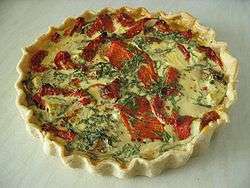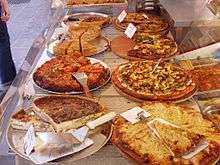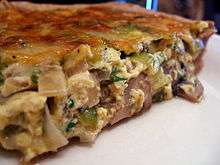Quiche
Quiche (/ˈkiːʃ/ KEESH) is a French tart consisting of pastry crust filled with savoury custard and pieces of cheese, meat, seafood or vegetables. The best-known variant is quiche Lorraine, which includes lardons or bacon. Quiche can be served hot or cold. It is popular worldwide.
 Quiche | |
| Type | Savoury |
|---|---|
| Place of origin | France |
| Main ingredients | Pastry case filled with egg and cheese, meat, seafood or vegetables |
Overview
Etymology

The word is first attested in French in 1805, and in 1605 in Lorrain patois. The first English usage—"quiche Lorraine"—was recorded in 1925. The further etymology is uncertain but it may be related to the German Kuchen meaning "cake" or "tart".[1]
History
Quiche is considered a French dish; however, using eggs and cream in pastry was practised in English cuisine at least as early as the 14th century and Italian cuisine at least as early as the 13th century.[2] Recipes for eggs and cream baked in pastry containing meat, fish and fruit are referred to Crustardes of flesh and Crustade in the 14th-century The Forme of Cury[3] and in 15th-century cookbooks, such as the Italian Libro de arte coquinaria.[4]
Varieties
Quiche has a pastry crust and a filling of eggs and milk or cream. It can be made with vegetables, meat and seafood.
Quiche lorraine
Quiche lorraine (named after the Lorraine region of France) is a popular variant that was originally an open pie with eggs, cream and lardons. In English-speaking countries, modern preparations of the dish usually include mature cheese (Cheddar cheese often being used in British varieties), and the lardons are replaced by bacon.
Other varieties

There are many variants of quiche, using a wide variety of ingredients. Variants may be named descriptively, often in French, e.g. quiche au fromage (quiche with cheese) and quiche aux champignons (quiche with mushrooms) or conventionally, e.g. florentine (spinach) and provençale (tomatoes).
See also
References
- "quiche", Oxford English Dictionary, OUP 2015. Accessed 4 February 2016.
- "QUICHE", Centre Nationale de Ressources Textuelles et Lexicales. Accessed 12 February 2015. This source also notes the first reference to 1805, in J.-J. Lionnois, Hist. des villes vieille et neuve de Nancy..., Nancy, t. 1, p. 80 - "Storia origine delle torte salate". Italian Academy of Gastronomy.
- Hieatt, Constance; Butler, Sharon (1985). Curye on Inglysch: English culinary manuscripts of the fourteenth century (including the forme of cury. SS. 8. London: EETS.
- "Ancient Italian Cookbook" (PDF). Italophiles.com. Retrieved 5 December 2019.
- Austin, Thomas, ed. Two Fifteenth-Century Cookery Books. London, EETS OS 91, 1888, repr. 1964.
Further reading
- Ange, E., & Aratow, P. (2005). La bonne cuisine de Madame E. Saint-Ange: the original companion for French home cooking. Berkeley: Ten Speed Press.
- Nathan, J. (2010). Quiches, Kugels, and Couscous: my search for Jewish cooking in France. New York: Alfred A. Knopf
- "Quiche Origins, History & Recipes". Foodreference.com. Retrieved 17 March 2012.
External links
| Wikimedia Commons has media related to Quiches. |
| Wikiquote has quotations related to: Quiche |
| Wikibooks Cookbook has a recipe/module on |
- "French Food Culture and Recipes". France-property-and-information.com. Retrieved 17 March 2012.
- "Classic Quiche Lorraine". Cooks.com. Retrieved 17 March 2012.